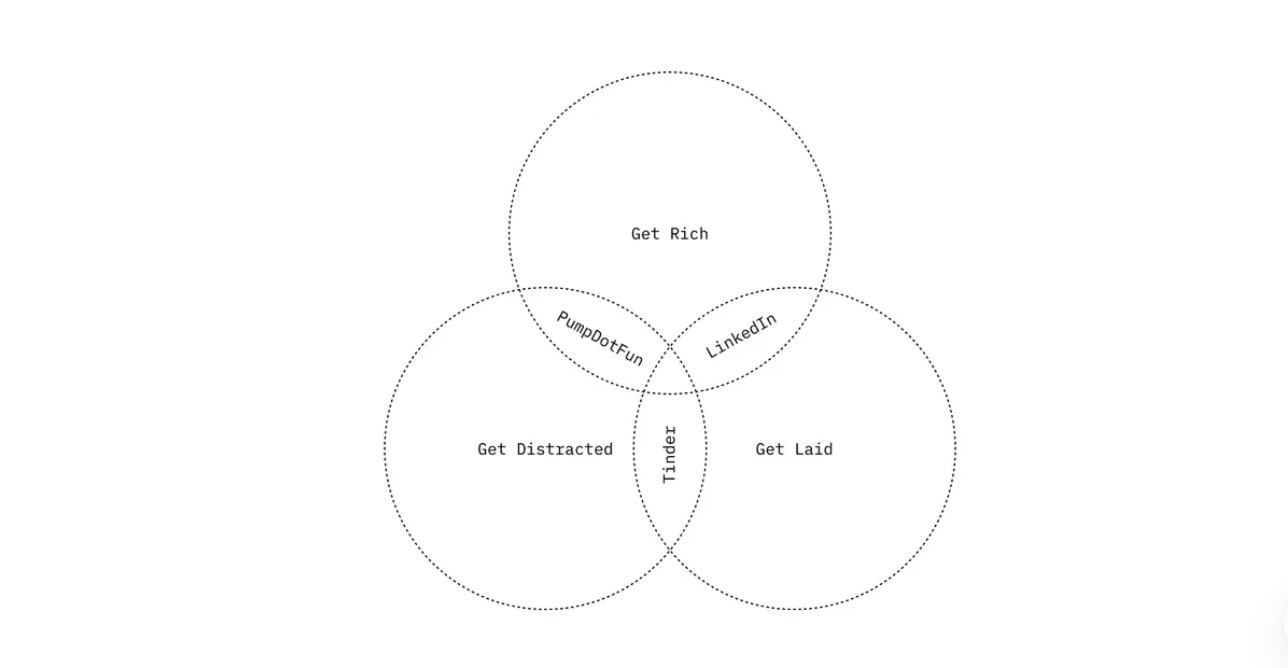Viewpoint: Encryption applications should focus less on technology and more on demand
Author: rm
Compiled by: Xiaobai Navigation coderworld

Consumer product apps are really hard to make! We, the notorious early adopters, are probably the only ones who get excited about faster transactions than the real world. But let’s be honest, speed doesn’t matter that much if there’s a great waiting interface so users aren’t bored.
What really matters is - to paraphrase Nikita Bier -Most consumer apps fall into three categories: getting rich, social, and entertainment, and their intersections.
People hope that through these applicationsmake moneyOr saving money, having fun, or meeting people (whether colleagues, friends, or future family). These are the basic needs that consumer applications target, not the technology itself.
For years, we have been asking,“What can this technology do?”But for most consumer applications, the more important question is what do people want? How can technology enable those needs in new ways? Thinking in terms of technology often leads to unrealistic ideas.
So, first step: what need are we satisfying? Is it to get rich, to be social, or to be entertained? Then, how do we use technology or infrastructure to achieve that?
User onboarding and retention are two critical moments for a good app.Onboarding shouldn’t require users to connect to a service, click through a setup screen, or fill out a form before showing the app’s features. Every extra click is a way to lose users before they get to know the experience. You can even skip the login requirement — just show me content based on my address. Be brief and fast. Show value first, then get me invested.
Hook users as quickly as possible and provide an immediate positive experience. The more screens and clicks, the more users will churn. Onboard quickly and make users feel "this is fun" right away.
Now, how to retain users is a new challenge.When users don’t get what they expected when they signed up, they tend to leave. While there are many reasons why people return, for consumer apps it’s all about the content and relationships that keep users coming back. Remember, everything on-chain is like a giant online service game.
Acquiring quality content is difficult because the cost of migrating from existing platforms is high.You don’t want a ton of “I just signed up, glad to be here” posts, you want quality content. While new content formats help, they are easily copied, and novelty is hard to maintain these days.
If the content is difficult to access, then relationships become particularly important.People join a platform becauseXiaobai NavigationOur friends are here too. We face two main challenges: First, to expand the user base, we need to establish a suitableCommunityand strategy. By starting with a niche market, products tend to be stickier.cryptocurrencyThe new incentive structure brought about by this is that if a consumer application is full of "speculators", then only designs around getting rich will work.
如果用户是为了社交或娱乐而来,他们可能会感到被疏远。因此,从一开始就要为合适的社区进行设计。
How to build an application?
In simple terms: What problem does your app solve? Can users use it to get rich, make friends, or have fun? Can they get a good experience immediately without tedious operations? Can the content and other users attract them to use it again? How can you leverage user-generated content and users themselves to drive new users to join?
This is very different from traditional on-chain thinking: less emphasis on “contractpriority”, and pay more attention to “demand priority”.
Building consumer applications in Web2 usually requires building account systems, social networks, payment systems, and data storage from scratch.BlockchainIn reality, these functions are readily available. So, instead of using your imagination in technology, you can rethink how to use existing modules to create something new. You can use Farcaster or Lens to build a social network, and usewalletAs an account, use on-chain operations such as Enso to complete transactions and conduct extensive prototyping.
In the past, on-chain technology was very complex, and you needed to have full confidence in your ideas because complex engineering design was required. Consumer applications are different: first, you need to clarify the needs, then use existing technology modules and quickly adjust them until you find a solution that suits consumers. Consumer products rarely start with a single idea - they evolve through continuous real-time iteration.
Innovation should be reflected in user experience rather than technology itself. Make good use of existing modules.
The article comes from the Internet:Viewpoint: Encryption applications should focus less on technology and more on demand
市场需要一个“山寨季”,来拯救被套牢的币圈VC们。 “这几天我和一些同行聊,这轮币圈VC基本死完了,幸好我们没怎么投一级,而是转向了二级。” “和做市商的人聊天,他很同情我们VC,项目上线第一年VC都拿不到币,只有做市商,项目和交易所有币,但是价格被砸下来却是…